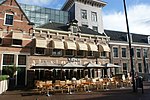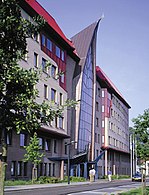Enschede fireworks disaster

The Enschede fireworks disaster was a catastrophic fireworks explosion on 13 May 2000 in Enschede, the Netherlands. The explosion killed 23 people including four firefighters and injured nearly 1,000. A total of 400 homes were destroyed and 1,500 buildings damaged. The first explosion had a strength in the order of 0.8 tons of TNT (3.3 GJ), while the strength of the final explosion was in the range of 4–5 tons of TNT (17–21 GJ). The biggest blast was felt up to 30 kilometres (20 mi) away. Fire crews were called in from across the border in Germany to help battle the blaze; it was brought under control by the end of the day. S.E. Fireworks was a major supplier to pop concerts and major festive events in the Netherlands. Prior to the disaster it had a good safety record and met all safety audits.
Excerpt from the Wikipedia article Enschede fireworks disaster (License: CC BY-SA 3.0, Authors, Images).Enschede fireworks disaster
Lonnekerspoorpad, Enschede
Geographical coordinates (GPS) Address Nearby Places Show on map
Geographical coordinates (GPS)
| Latitude | Longitude |
|---|---|
| N 52.230277777778 ° | E 6.8933333333333 ° |
Address
Vloerplaten SE Fireworks
Lonnekerspoorpad
7523 JG Enschede
Overijssel, Netherlands
Open on Google Maps








